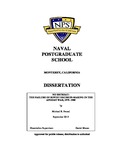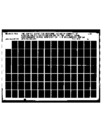No retreat: the failure of Soviet decision-making in the Afghan War, 1979-1989
Abstract
In 1979, the Soviet Union invaded Afghanistan to settle a quarrel among competing factions within the recently installed communist government, and to suppress the anti-communist resistance that the Afghan governments ideology and conduct had inspired among the population. This dissertation examines the Soviet decision-making surrounding what proved to be a decade-long military effort. It focuses on the way political decision-making at the highest levels of the Soviet state shaped the wars origins, conduct and outcome, with particular attention on the politics and inner workings of the Politburo, the most senior collective decision-making body in the government. Like most wars, the outcome of the Soviet-Afghan War appears over determined in retrospect. There is no claim here that the Soviet defeat can be attributed to their having missed some readily apparent path to victory, nor a claim that the Afghan war would have been won but for mistakes made in Moscow. Yet it remains true that the senior leadership of the Soviet Union quickly became aware that their strategy was unraveling, that their operational and tactical methods were not working, and that the sacrifices they were demanding from the Soviet people and military were unlikely to produce the results they hoped for. They persisted nonetheless. This study explains why and how that happened, as viewed from the center of the Soviet state. From that perspective, three sources of failure stand out: poor civil-military relations; repeated and often rapid turnover at the very summit of Soviet leadership; and the perception among Politburo members that Soviet global prestige and influence were inexorably tied to the success of the Afghan mission, which caused them to persist in their pursuit of a policy long after it was clearly unobtainable.
Collections
Related items
Showing items related by title, author, creator and subject.
-
NSA Alumus promoted and published
National Security Affairs (Monterey, California. Naval Postgraduate School, 2017-12-17);Colonel Michael Fenzel (US Army), who defended his ph.D. dissertation in the NSA Department in 2013 ("No Retreat: the Failure of Soviet Decision-making in the Afghan War, 1979-1989"), has been promoted to brigadier general ... -
The Soviet Quest for Regional Security Studies of Foreign Policy Decision-Making in the USSR
Dellenbrant, Jan A. (Monterey, California. Naval Postgraduate School, 1986-09); NPS-56-86-002This study deals with three cases where the regional security aspect of Soviet decision-making was important. Firstly, the Baltic region will be considered. The Soviet strategy for promoting stability in the Baltic republics ... -
FROM TRUST TO TREACHERY: UNRAVELING SOVIET INTELLIGENCE TACTICS IN THE 1920S AND 1930S
Atherton, Daniel J. (Monterey, CA; Naval Postgraduate School, 2023-12);This thesis examines why the Soviet Union’s intelligence service, in its efforts to neutralize the White Russian movement, chose strategic deception as its primary tactic in the 1920s and political violence in the 1930s. ...



 13Sep_Fenzel_Michael_PhD.pdf (741.3Kb)
13Sep_Fenzel_Michael_PhD.pdf (741.3Kb)

